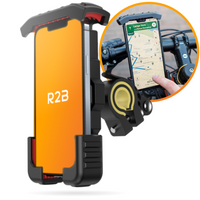No Products in the Cart

How Do Touchscreen Gloves Work?
Time to read 4 min
Time to read 4 min
With winter approaching and smartphones becoming an indispensable part of everyday life, it’s no wonder that touchscreen gloves are becoming increasingly popular. These gloves promise to keep your fingers warm while you operate your smartphone. But how exactly do these gloves work? And what makes them suitable for operating a touchscreen that regular gloves can’t? Let’s take a closer look at the technology behind touchscreen gloves .
To understand how touchscreen gloves work, it’s helpful to first understand why regular gloves aren’t suitable for touchscreens. Most modern smartphones have a capacitive touchscreen, meaning that they detect touches through the electrical conductivity of our skin. This type of screen has a thin, conductive layer that responds to the electrical charge of a finger. When you touch the screen, the electrical charge at that specific point changes, and this change is registered by the device as a touch.
Regular gloves block this electrical charge because they are usually made of non-conductive materials such as wool, leather or cotton. This prevents the screen from detecting that you are touching it, resulting in a non-functioning touch. Touchscreen gloves solve this problem by adding conductive materials so that they work on the screen just like your bare fingers.
Touchscreen gloves use special materials and techniques to make contact with the screen possible. There are several ways manufacturers approach this:
One of the most common techniques is to add conductive yarns to the glove. These yarns, often made of materials such as silver, copper or carbon, are incorporated into the fabric of the glove, usually in the fingertips. These materials conduct electricity and can therefore transfer the electrical charge from your skin to the screen.
Some touchscreen gloves have a conductive coating on the fingertips. This can be a layer of electrically conductive material that is applied to the glove, which still allows the touchscreen to respond to touch. This coating acts as an "extension" of your finger and ensures that your hands stay warm without having to remove the gloves.
There are also gloves on the market where the entire surface is conductive. This means that you can use any part of your hand to operate the screen. These types of gloves are ideal for people who make a lot of different finger movements on their touchscreen, such as typing or scrolling, because they are not limited to using only the fingertips.
Touchscreen gloves come in a wide variety of materials and styles. Each material has its own advantages and disadvantages when it comes to warmth, durability, and functionality.
Many touchscreen gloves are made of wool or cotton, but contain conductive threads in the fingertips. These gloves provide a basic level of warmth and are usually affordable, but they may not be suitable for very cold temperatures.
Leather touchscreen gloves offer an elegant look and are often warmer and more durable than wool or cotton gloves. The leather itself is not conductive, but these gloves are treated with a special coating on the fingertips so that they still work on touchscreens. They are often a bit more expensive, but are popular for their comfort and style.
Synthetic materials such as fleece and polyester are popular in sporty touchscreen gloves. They often offer good grip and are wind and water resistant, making them suitable for outdoor activities. These gloves usually have a conductive coating or thread in the fingertips, which ensures reliable touchscreen operation even during active activities.
To get the most out of touchscreen gloves, there are a few things to keep in mind.
A good fit is important for touchscreen gloves. Gloves that are too loose can make it difficult to type or scroll accurately. Gloves that fit your fingers snugly provide better contact with the screen, which means your touches are registered more accurately.
Many touchscreen gloves only have conductive materials in the index and middle fingers. Therefore, use these fingers to operate the screen. Gloves where the entire surface is conductive give you more freedom in your choice of fingers.
To maintain the conductivity of touchscreen gloves, proper care is important. Wash them gently in cold water and use a mild detergent. Avoid hot water and dry your gloves flat to prevent damage to the conductive materials. Washing too often can reduce the conductive properties, so limit washing to when it is really necessary.
Touchscreen gloves are ideal for basic use, such as calling, messaging and scrolling, but can sometimes have limitations. The sensitivity of the screen can be less precise than when touched with a bare finger. This makes it difficult to perform very precise actions, such as typing longer messages. In addition, extreme cold and moisture can negatively affect the conductive properties of the gloves, resulting in reduced performance in very cold conditions.
If your touchscreen gloves aren’t working properly, try keeping them clean and dry first. You can also check your phone’s settings; some devices have an option for enhanced sensitivity that helps with gloved use. If this doesn’t work, it could be that the conductive properties of your gloves have diminished over time, and it may be time for a new pair.

